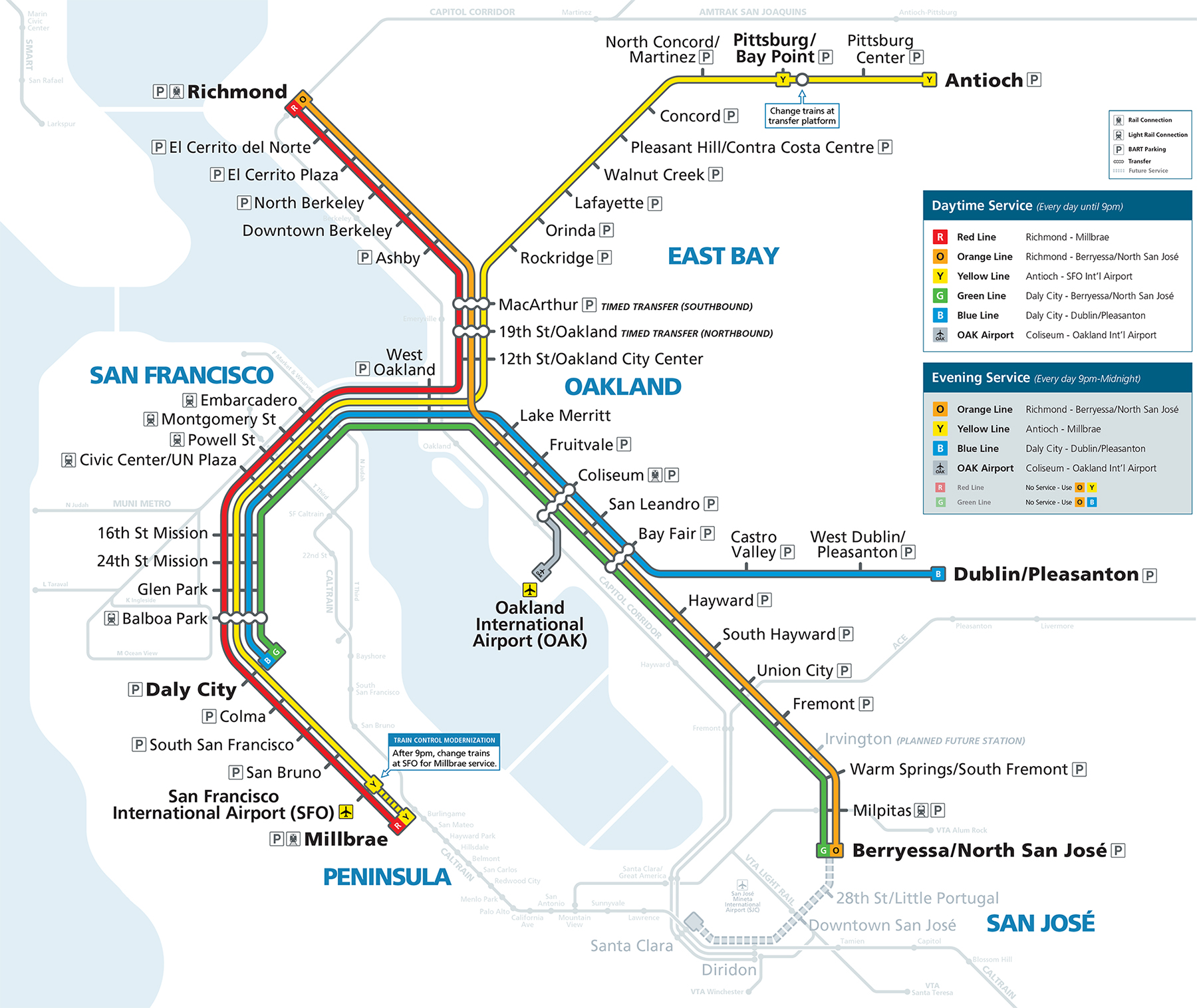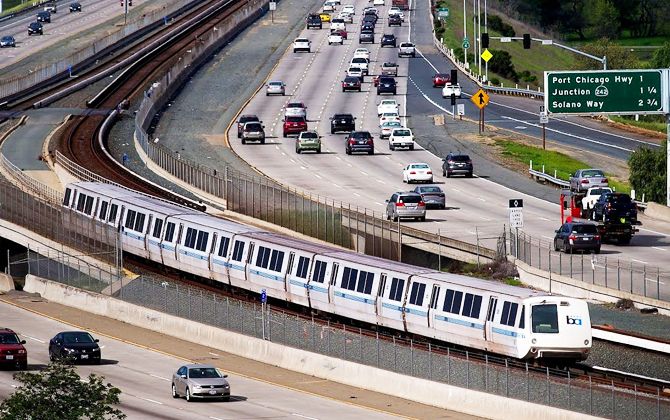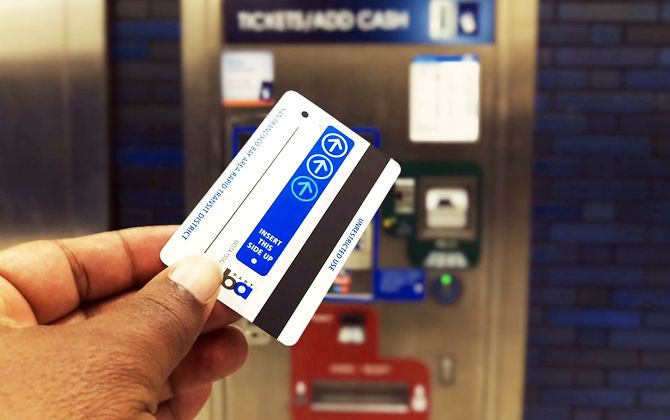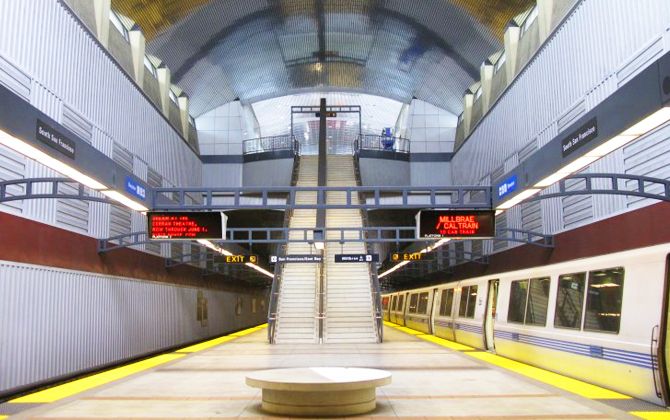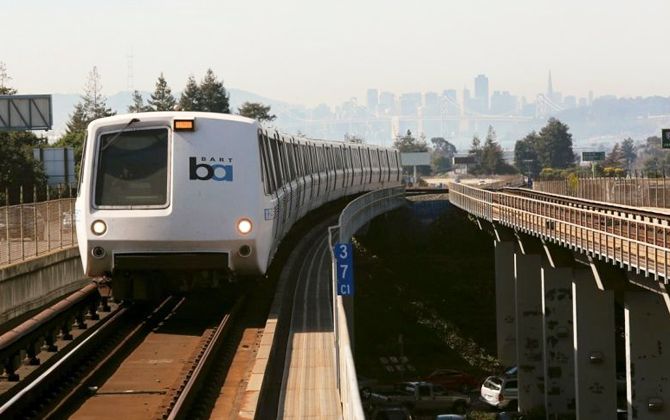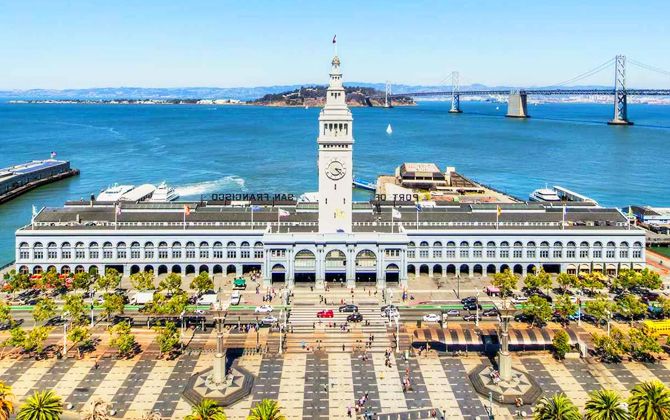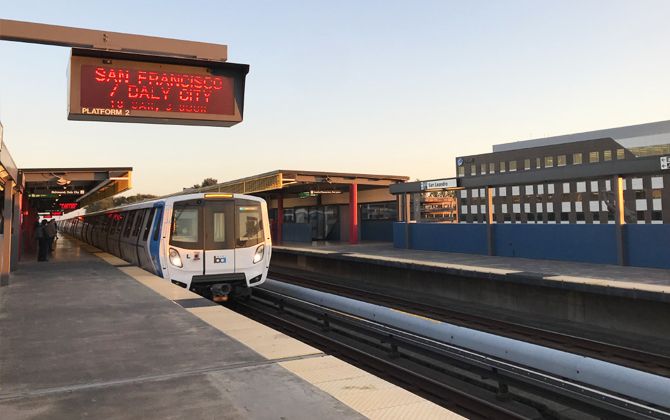Bay Area Rapid Transit (BART) is the metro system serving the San Francisco Bay Area. It connects San Francisco, Oakland, Berkeley, Fremont, Walnut Creek, Dublin/Pleasanton, and other cities.
As of 2026, BART runs on five lines with 50 stations, covering about 131 miles (211 km) of track. The network links San Francisco, Alameda, Contra Costa, San Mateo, and Santa Clara counties. Routes include underground, elevated, and surface sections.
BART opened in 1972 and was one of the first U.S. systems to use automated train control. It has long ranked among the busiest metros in the country, historically fifth by ridership, with hundreds of thousands of daily passengers before the pandemic.
San Francisco Metro Map
The 2026 BART map shows a rail network spreading from the San Francisco–Oakland core to the suburbs. BART has five color-coded lines that share tracks on main routes. Four of them pass through downtown San Francisco via the Transbay Tube, the underwater tunnel linking to Oakland. The fifth line, Richmond–Warm Springs, stays entirely in the East Bay and does not cross into San Francisco.
Each line is marked by its endpoints and a color: Yellow, Blue, Orange, Green, or Red. The Yellow Line runs from Pittsburg/Bay Point to San Francisco International Airport. The Blue Line connects Dublin/Pleasanton with Daly City. Key transfer hubs such as MacArthur, Bay Fair, and 19th St/Oakland allow riders to switch lines easily.
Map of San Francisco Metro showing different lines. Click on the map to enlarge it or download the San Francisco BART map in PDF format.
Lines and Stations of BART
BART has five main lines, named after their end terminals and marked by color. Below are the routes and stations in 2026.
Richmond–Warm Springs/South Fremont Line
The Orange Line runs in the East Bay, linking Contra Costa and Alameda counties. Since 2020 it extends to Milpitas and Berryessa/North San José. It has 21 stations from Richmond to Berryessa.
Trains usually run the full route on weekdays. Late at night some turn back at Warm Springs. A full ride takes about one hour (96 km / 60 mi).
Pittsburg/Bay Point–SFO/Millbrae Line
The Yellow Line is the longest route. It runs from Pittsburg/Bay Point through Oakland and San Francisco, then down the Peninsula to Millbrae. At Pittsburg/Bay Point, riders can transfer to eBART trains for Antioch.
This is the only line serving SFO directly. During core hours trains run through SFO to Millbrae. After 9 PM some end at Millbrae with a shuttle to SFO. A full trip from Antioch to Millbrae takes about 85 minutes.
Warm Springs/South Fremont–Daly City Line
The Green Line runs from Berryessa/North San José through Fremont and Oakland, then under the Bay to Daly City. It has about 20 stations.
After 9 PM it goes offline, with service covered by other lines. It may not run on Sundays. When active, it offers a direct ride from Fremont-area stations to downtown San Francisco.
Richmond–Daly City/Millbrae Line
The Red Line starts in Richmond, passes through Oakland, crosses to San Francisco, and continues to Millbrae. It serves about 23–24 stations.
On weekdays it runs in daytime and early evening. After 9 PM and on Sundays, service may stop at Daly City, with coverage by the Yellow Line. When operating, it provides a one-seat ride from Richmond and Berkeley to San Francisco and the Peninsula.
Dublin/Pleasanton–Daly City Line
The Blue Line, opened in 1997, links Dublin/Pleasanton with Oakland and San Francisco. It has 18 stations and ends at Daly City.
It runs daily, about 5 AM to midnight on weekdays (later start on weekends). A trip from Dublin/Pleasanton to downtown San Francisco takes 50–60 minutes. Bay Fair, MacArthur, and 19th St are key transfer points.
Schedule & Operating Hours
BART runs daily from early morning to midnight. Weekdays: 5 AM–12 AM; Saturdays: 6 AM–12 AM; Sundays: 8 AM–12 AM. There is no service overnight (roughly midnight–5 AM). Plan ahead for the last trains, which leave near midnight.
Train frequency is about every 15 minutes during the day and rush hours. In central San Francisco, overlapping lines mean trains arrive as often as every 2–3 minutes at peak. After 9 PM, service drops to three lines (Yellow, Blue, Orange) with trains about every 20 minutes. On weekends, trains run about every 20 minutes.
The Green and Red lines often do not run late at night or on Sundays; their routes are covered by other lines.
Ticket Pricing and Purchases
Fares are distance-based. In 2026, one-way adult rides cost from about $2.40 (≈₽220) to $16.20 (≈₽1,490). Short trips within San Francisco cost around $2–3, while long trips such as SFO to Antioch reach the upper range. Extra charges apply for SFO trips, crossing the Bay, or entering San Mateo County, but these are included in your fare. Children under 5 ride free.
Payment is only through Clipper card (physical or mobile). Paper tickets are no longer accepted. A new card costs $3, and fares are deducted automatically when you tap in and out.
Discounts:
- Youth (5–18) pay 50% less
- Seniors (65+) and riders with disabilities get 62.5% off
- and low-income adults (Clipper START program) get 50% off.
No daily or weekly passes are offered; you pay per trip.
Connecting to Other Transport Systems
BART is closely integrated with other Bay Area transit.
- In San Francisco, the four downtown stations connect to Muni Metro light rail and many bus routes, though a separate fare is required.
- At Powell Street you can also reach cable cars.
- On the Peninsula, Millbrae Station links directly to Caltrain for trips to cities like Palo Alto and Mountain View.
- In the East Bay, most stations connect with AC Transit buses.
- Downtown Oakland stations are major hubs, and AC Transit also runs overnight Transbay buses when BART is closed.
- With the Santa Clara County extension, Milpitas and Berryessa/North San José stations connect to VTA light rail and bus routes into San Jose and Silicon Valley.
- Richmond and Coliseum stations connect directly to Amtrak Capitol Corridor trains, while SamTrans buses serve BART stations in San Mateo County such as Daly City and Millbrae.
- ACE commuter rail has shuttle links from Pleasanton and Fremont stations, and from Embarcadero it is only a short walk to the Ferry Building for Bay Ferry services.
Transfers usually require a new fare, though Clipper card users may receive discounts.
Connecting to Airports
BART provides direct service to SFO and Oakland airports. At San Francisco International Airport, the station is inside the International Terminal and served by the Yellow Line. From downtown San Francisco, the ride takes about 30 minutes. Fares include a surcharge of about $5 (≈₽460). Late at night, service may require a shuttle connection at Millbrae.
Oakland International Airport is connected by a short automated shuttle from Coliseum Station. The ride takes about 8 minutes and trains depart every 6–9 minutes during operating hours. The surcharge is about $6 (≈₽550) on top of the BART fare to Coliseum. San Jose Mineta Airport is not served directly; the nearest stations are Milpitas and Berryessa with onward travel by VTA bus or rideshare.
Parking
Many suburban BART stations offer parking, though demand is high on weekday mornings. Lots usually charge $3–6 (≈₽275–550) per day, with higher rates at West Oakland (~$12 / ≈₽1,100). Payment is made at station machines, online, or via the app. Parking is free after 3 PM, on weekends, and on most holidays. Reserved permits are available, costing about $30–120 (≈₽2,750–11,000) per month depending on location.
Spaces at busy stations like Dublin/Pleasanton, Fremont, Daly City, and Millbrae often fill before 7:30 AM, so arriving early or buying a permit is recommended. Motorcycles park free in designated areas, and most stations have bike racks or lockers.
Overnight parking is limited and usually requires a multi-day permit. Downtown San Francisco and central Oakland stations do not have public parking.
Tips and Advice
- Stations have monitors showing the next trains.
- Remember BART is not 24-hour. Last trains leave downtown San Francisco for the East Bay around 12:20 AM. After that, only limited AC Transit night buses run.
- Weekday rush hours (7–9 AM, 4:30–6:30 PM) are crowded, especially in the Transbay Tube. Trains run often but seats are scarce. Midday and weekends are less crowded, though events can make trains busy.
- On escalators, stand on the right and walk on the left – a common local practice. Eating and drinking are not allowed inside stations or trains.
- Let passengers exit before boarding. Most trains now use the newer “Fleet of the Future” cars with more space and digital displays. Areas for wheelchairs and bikes are clearly marked. If standing, hold on – trains accelerate quickly.
- Bikes are allowed at all times but not in the first car. Avoid blocking doors and use elevators or escalators when moving bikes between levels.
- If parking, note your stall number or license plate, as you’ll need it to pay. Lots at busy stations fill early on weekdays, often by 7:30 AM. After 3 PM and on weekends, parking is usually free and more available.
- All stations have elevators for accessibility, though some may be out of service. Trains have designated spaces for wheelchairs, and reduced fares are available with the RTC card for riders with disabilities.
- Overall, BART is straightforward to use. Signs and announcements guide you, and station agents are available for help. Locals are generally friendly and willing to assist visitors.
History of BART
Plans for BART began in the 1950s, when regional leaders proposed a modern transit system. The Bay Area Rapid Transit District was formed in 1957, with San Francisco, Alameda, and Contra Costa counties joining. Marin and San Mateo later withdrew.
Construction started in 1964. Its most ambitious project was the Transbay Tube, a 3.6-mile (5.8 km) underwater tunnel linking Oakland and San Francisco, completed in 1969. BART chose a broad 5 ft 6 in gauge for smoother high-speed rides and introduced automated train control, new at the time.
Service began on September 11, 1972, with trains between Oakland’s MacArthur and Fremont. By 1973, service extended north to Richmond and south to Fremont. In 1974, the Transbay Tube opened, connecting to new San Francisco stations and Daly City. Embarcadero Station followed in 1976, completing the original 71-mile network.
Expansion resumed in the 1990s: Pittsburg/Bay Point opened in 1996, Dublin/Pleasanton in 1997, and the SFO/Millbrae extension in 2003. Later projects included the Oakland Airport Connector (2014), West Dublin/Pleasanton station (2011), Warm Springs extension (2017), Antioch eBART (2018), and the Silicon Valley Phase I to Milpitas and Berryessa (2020).
By 2020, BART had about 50 stations and 131 miles (211 km) of track. The COVID-19 pandemic reduced ridership but accelerated upgrades, including new “Fleet of the Future” trains, which replaced the original 1970s cars in 2023.
Attractions to Visit
BART is useful not only for commuters but also for tourists. It takes you close to many attractions in San Francisco, Oakland, and Berkeley, often with just a short walk or transfer.
- Union Square: Powell Street Station is a short walk from Union Square and the cable cars to Fisherman’s Wharf.
- Embarcadero & Ferry Building: Embarcadero Station opens at the Ferry Building Marketplace with shops, food, and ferries. Alcatraz ferries leave from Pier 33, a short ride or walk away.
- SFMOMA & Yerba Buena: Montgomery Station is close to the SF Museum of Modern Art and Moscone Center.
- Chinatown & North Beach: Reachable on foot or by bus from Montgomery or Powell.
- Mission District: 16th St and 24th St Mission stations bring you to murals, Dolores Park, and local taquerias.
- Golden Gate Park & Bridge: Take BART to Civic Center or Embarcadero, then connect to Muni buses. The bridge is outside BART’s direct reach but accessible with a transfer.
- Oracle Park: From Embarcadero or Montgomery, walk about 20 minutes or take Muni T-line to the Giants’ baseball stadium.
- Downtown/Uptown Oakland: 12th St and 19th St stations are near theaters, bars, and restaurants.
- Jack London Square: A 15-minute walk or short ride from 12th St Station.
- Oakland Museum of California: Five minutes from Lake Merritt Station.
- Lake Merritt: Scenic city lake near 19th St and Lake Merritt stations.
- Oakland Zoo: From Coliseum Station, connect by bus or rideshare.
- Redwood Regional Park: Best reached by car or bike. Tilden Park in Berkeley is more accessible by bus.
- UC Berkeley: Downtown Berkeley Station is next to campus and the BAMPFA museum. Shattuck Avenue’s Gourmet Ghetto is nearby.
- Tilden Regional Park: Accessible by AC Transit from downtown Berkeley.
- Bay Trail & Views: West Oakland Station is near the Bay Bridge bike path. Coliseum Station serves the Oakland Coliseum.
- Shopping: Embarcadero Center (Embarcadero), Westfield SF Centre (Powell), Bay Fair Center (Bay Fair), and Stoneridge Mall (via bus from Dublin/Pleasanton).
BART makes visiting these places easy and avoids parking hassles. It also offers unique views, like the Bay from West Oakland or elevated tracks in East Bay.
Fun Facts
BART uses a broad 5 ft 6 in (1676 mm) gauge, wider than standard rail, chosen for smoother high-speed rides. The Transbay Tube, 3.6 miles (5.8 km) long and 135 feet deep, was the world’s longest underwater transit tunnel when it opened in 1974. Trains reach up to 70 mph (113 km/h), making BART one of the fastest U.S. metro systems.
BART was a pioneer in automation, with computer-controlled speed and braking since the 1970s. In 2023, the last 1970s-era trains were retired, replaced by a new “Fleet of the Future” with digital displays, better climate control, and more space for bikes and luggage.
Before COVID-19, weekday ridership averaged about 405,000 trips, making BART the fifth-busiest U.S. metro. Ridership dropped to about 165,000 in 2024 but is recovering. The busiest stations are Embarcadero and Montgomery in downtown San Francisco.
Other curiosities: some stations once had “Library-a-Go-Go” book vending machines; the longest one-seat ride is Berryessa/North San José to Millbrae (about 62 miles / 100 km, 1 hour 40 minutes); Civic Center is one of the deepest stations (about 120 feet underground); and Montgomery has one of the Bay Area’s longest escalators. BART is also built for earthquake safety, with automatic shutdown systems and reinforced structures.
BART often appears in films and books, from “Fruitvale Station” to Pixar’s “Inside Out,” cementing its place in Bay Area culture.
Future Expansions
BART continues to grow. The major project is Silicon Valley Phase II, extending from Berryessa through downtown San Jose to Santa Clara. This 6-mile (9.6 km) project with four new stations is underway, aiming for completion around 2036–2037.
Other projects include a new Irvington Station in Fremont (expected ~2026), an eBART extension to Brentwood, and long-term plans for a second Transbay crossing (Link21), which could add major new routes and capacity. BART is also upgrading train control systems, stations, and fare gates, and planning infill stations like 30th St Mission.
These expansions will strengthen BART’s role as the Bay Area’s backbone, eventually linking San Francisco and San Jose directly and preparing for future regional growth.
